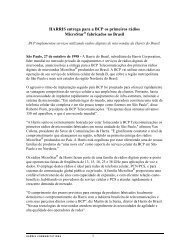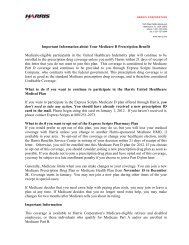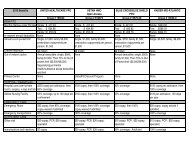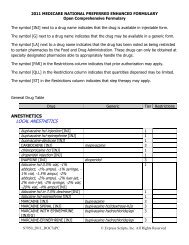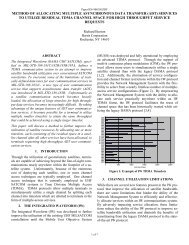harris corporation
harris corporation
harris corporation
You also want an ePaper? Increase the reach of your titles
YUMPU automatically turns print PDFs into web optimized ePapers that Google loves.
Over the longer term, DoD budgets are expected to decrease from current levels. While the DoD budget<br />
proposed by the Administration in February 2011 reflects a modest growth rate of approximately 2% from GFY<br />
2012 through GFY 2021, recently enacted debt-ceiling legislation requires reductions of approximately $350 billion<br />
in Pentagon and national security agency budgets over the next ten years. Further, if a House-Senate committee is<br />
unsuccessful in reaching an agreement upon a deficit reduction plan by late November 2011, the recently enacted<br />
debt-ceiling legislation requires significant cuts in federal spending, which would be expected to result in deeper<br />
reductions to DoD budgets. Despite the expected lower levels of defense spending and the cancellation of particular<br />
platforms and programs, the types of products and services we offer appear to be a funding priority over the long<br />
term, which we believe will positively affect our future orders, sales, income and cash flows. Conversely, a<br />
significant decline in defense spending or a shift in funding priorities may have a negative effect on future orders,<br />
sales, income and cash flows depending on the platforms and programs affected by such budget reductions or shifts<br />
in funding priorities.<br />
Other Federal Markets: Another current funding priority for the U.S. Government is the security of the United<br />
States, which includes better communications interplay among law enforcement, civil government agencies,<br />
intelligence agencies and our military services. Funding for investments in secure tactical communications, IT,<br />
information processing, healthcare IT, cyber security and additional communications assets and upgrades has remained<br />
solid. Another current priority of the U.S. Government is investments in productivity, cost reductions and upgrading to<br />
new IT systems and solutions. As a result, programs that promote these initiatives are also expected to receive funding,<br />
although there is no assurance that such funding will remain a priority. We provide products and services to a number<br />
of U.S. Government agencies including the FAA, NRO, NGA, Department of State, NSA, NOAA and others. For<br />
example, the FAA has announced its Next Generation Air Transportation System (“NextGen”) program to transform<br />
the entire U.S. air transport system to meet future demands and avoid gridlock in the sky and at airports.<br />
State and Local: We also provide products to state and local government agencies that are committed to<br />
protecting our homeland and public safety. Despite near-term budget pressures for state and local government agencies,<br />
we believe more normal spending patterns will resume in the long term as these agencies continue upgrading their<br />
technologies to improve communications and interoperability, although there can be no assurance they will do so.<br />
International: Recently, we have experienced a delay in international orders due to continuing political<br />
uncertainty in Northern Africa, the Middle East and Central Asia. However, over the longer term, we believe<br />
demand for communications and IT infrastructure technology and services in emerging global markets will remain<br />
robust. International markets continue to drive toward tactical communications upgrades and interoperability. We<br />
have also identified substantial opportunities with international governments with respect to their defense spending<br />
on national security and on tactical communications modernization and standardization programs, which we believe<br />
will positively affect our future orders, sales, income and cash flows.<br />
Government Oversight and Risk: As a U.S. Government contractor, we are subject to U.S. Government<br />
oversight. The U.S. Government may investigate our business practices and audit our compliance with applicable<br />
rules and regulations. Depending on the results of those investigations and audits, the U.S. Government could make<br />
claims against us. Under U.S. Government procurement regulations and practices, an indictment or conviction of a<br />
government contractor could result in that contractor being fined and/or suspended from being able to bid on, or<br />
from being awarded, new U.S. Government contracts for a period of time. Similar government oversight exists in<br />
most other countries where we conduct business. We are currently not aware of any compliance audits or<br />
investigations that could result in a significant adverse impact to our financial condition, results of operations or<br />
cash flows.<br />
We are also subject to other risks associated with U.S. Government business, including technological<br />
uncertainties, dependence on annual appropriations and allotment of funds, extensive regulations and other risks,<br />
which are discussed in “Item 1A. Risk Factors” and “Item 3. Legal Proceedings” of this Report.<br />
Commercial: We are working to leverage our proven technologies for government applications into attractive<br />
commercial applications and expand in high-growth commercial markets. These markets include IT services,<br />
managed services, cyber integration and media solutions supporting energy, healthcare, broadcast and enterprise<br />
networks. We are trusted to run some of the United States’ largest, secure mission-critical information networks, and<br />
demand for communications and IT infrastructure in emerging global markets remains robust. As a cyber integrator,<br />
we see a large opportunity to help large <strong>corporation</strong>s move their complex IT enterprises to a trusted cloud<br />
environment in order to reduce costs, expand IT service delivery and increase security and compliance. Trends and<br />
developments in the broadcast and new media solutions market include the continuing worldwide transition to<br />
digital and HD technologies; a rebound in the global ad spending market; increasing demand for new systems to<br />
deliver rich media content to live sports and entertainment venues, retail establishments and mobile handheld<br />
38




